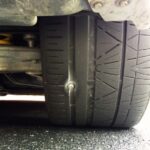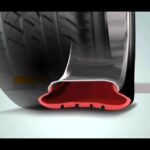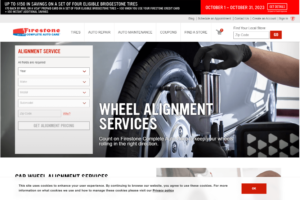Fix-a-Flat is a convenient solution if you get a flat tire. But you shouldn’t drive for too long or too far with it in the tire. How long can you drive on a tire with Fix-a-Flat?
You can drive up to 2 to 4 miles (3.2 to 6.4 km) on a tire with Fix-a-Flat. If you drive longer, the Fix-a-Flat will corrode and damage the wheel.
Immediately after using Fix-a-Flat, you should drive to a mechanic or tire repair shop. Driving right after using Fix-a-Flat will increase the tire’s pressure and cause the sealant to be evenly distributed in the tire.
Fix-a-Flat works well with a nail in the tire or a slow leak around a small section of the wheel’s rim. But it is just a temporary solution.
You remove the cap from your tire valve. Connect the Fix-a-Flat tube to the tire valve (just like when inserting air), press the button on the Fix-a-Flat canister, and the sealant flows into the tire. The liquid substance solidifies against the inside rubber of the tire. The idea is for it to spread so that it covers the hole from the inside.
Read on to learn more about how long you can drive on a tire with Fix-a-Flat and how to use it properly.
Also, take a look at Fix-a-Flat on Amazon to see more information on it, its reviews, and its price.
Click here to see Fix-a-Flat on Amazon.
How Long Can You Drive on a Tire with Fix-a-Flat?
It is not advised to drive longer than about 2 to 4 miles on Fix-a-Flat. If you drive on a tire with Fix-a-Flat, you risk damaging the tire. Fix-a-Flat hardens and will corrode the wheel rim if it is in for too long.
There are people who have driven for years on a tire with Fix-a-Flat in it to seal a leak; however, this is risky. You run the risk of having the screw or nail that causes the hole in the first place to start causing the tire to leak again, flattening your tire for a second time.
The best thing to do after using Fix-a-Flat is to drive your car to the nearest tire repair shop. You must drive the car immediately after the Fix-a-Flat goes into the tire. This will cause the tire’s pressure to build up and let the sealant evenly distribute in the tire.
Once the sealant is inside the tire, it will harden against the inside wall of the tire. Then it seals the hole where the air is escaping. The goo works well with nail holes because it can squirt through and set itself inside the tire.
Always remember that Fix-a-Flat is only a temporary fix. It can cause the tire to be unbalanced, resulting in a vibration problem while the car is running. Corrosion on the wheel’s rim is also one of the risks you face if you use this temporary fix.
Again, how long can you drive on a tire with Fix-a-Flat? Only drive on a tire with Fix-a-Flat for no more than 4 miles and ideally less.
Steps on How to Use a Fix-a-Flat
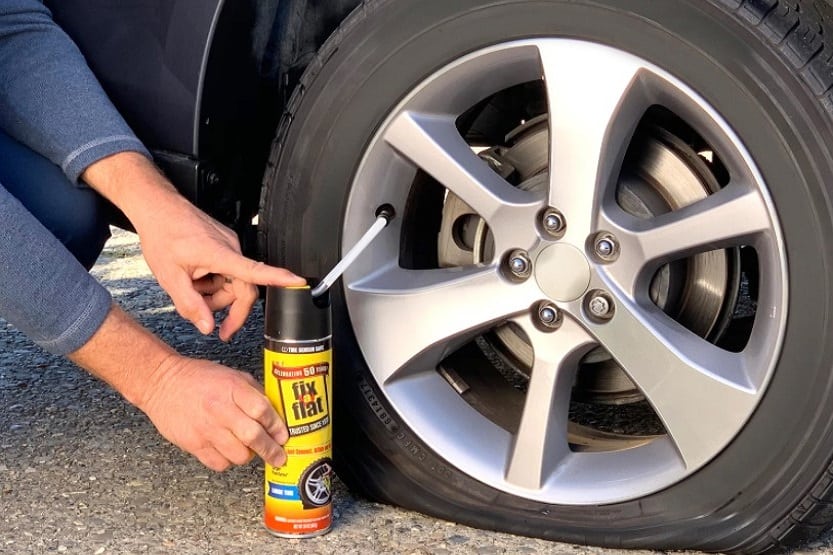
What Is Fix-a-Flat?
Fix-a-Flat is a tire repair aerosol that can quickly seal tire holes and prevent tire air leaks. This product acts as a tire sealant using a liquefied propellant to inflate the tire while its latex emulsion foams. It then hardens along the inside wall of the tire, which plugs the leak.
Just push a button on the can, and your tire will be inflated. You will be able to continue driving in no time. This sealant can seal up to 1/4 inch holes without using tire tools or a jack. A can of Fix-a-Flat contains a liquid sealant and a small amount of air.
How Long Does Fix-a-Flat Last for a Slow Leak?
Fix-a-Flat isn’t meant to remain inside a tire for a long time. It can work just enough for you to reach the nearest tire shop for a tire fix or replacement.
When you suspect that your tire is leaking, locate the place of the leak. If the hole or puncture is not bigger than 1/4 inch, you can use Fix-a-Flat. Bigger holes than this should be fixed differently. Once you’ve located the puncture, remove the cap of the tire valve.
Get the Fix-a-Flat ready by shaking the can. Connect the nozzle of the can to the tire valve. Then, push the button on the can. The air in the can will force or push out the tire sealant into the tire. Once inside the tire, the sealant will seek out the puncture and will seal it.
Your tire continues to fill up with air, and the tire rim will be lifted off from the ground. The foam can cover all the areas inside the tire. Once released from the can, the propellant will evaporate. It can expand and fill up the whole area inside the tire.
The propellant contains many substances. But the main ingredient is polymer latex. It is a milky substance like the latex contained in ordinary paints. When pushed out from the can, it will foam and fill the tire, sealing every hole, wherever it may be inside the tire.
As good as it may sound, it is still a temporary fix. You should have your tire permanently fixed or replaced after this short-term repair.
So how long does Fix-a-Flat work? Fix-a-Flat can work for 3 days or 100 miles, whichever comes first. It could keep your tire sealed for several years. Experts have said it can last 7-10 years, so it could outlast the tire itself – unless the tire goes flat again.
Once Fix-a-Flat activates the sealant and inflates the tire, you can drive the car to the nearest car tire shop to have it repaired or replaced.
Take a look at Fix-a-Flat on Amazon to see more information on it, its reviews, and its price.
Click here to see Fix-a-Flat on Amazon.
Factors That Determine How Long You Can Drive on a Tire with Fix-a-Flat
Many things can affect how long a tire with Fix-a-Flat can run. Here are some of the factors:
1. Size of the Hole
The biggest size of holes that Fix-a-Flat can plug, as prescribed by the manufacturer, is 1/4 inch. Of course, you can try sealing a tire hole bigger than 1/4 inch. You may be successful, but only for a short distance because the tire will run flat again. So, stick to what is recommended by the maker of this tire sealant.
2. Amount of Tire Sealant Used
Fill the entire inside area of the tire with foam to maximize the effectiveness of the sealant. If there is not enough foam to plug the holes, you won’t be able to drive too far. The tire can probably still run, but it will be uneven, making the car unsafe to drive.
3. Unsafe Road Surface
Driving a tire with Fix-a-Flat on road surfaces full of sharp objects and debris will cut short its already temporary life.
4. Sealant Is Semi-frozen
Using a semi-frozen tire sealant reduces its effectiveness. This problem is prevalent during cold weather and in the winter. The sealant can also freeze, making it inappropriate to use in chilly weather. Even if you defrost the sealant, it will refreeze when you put it inside the tire. It will cause the wheel to be out of balance as well.
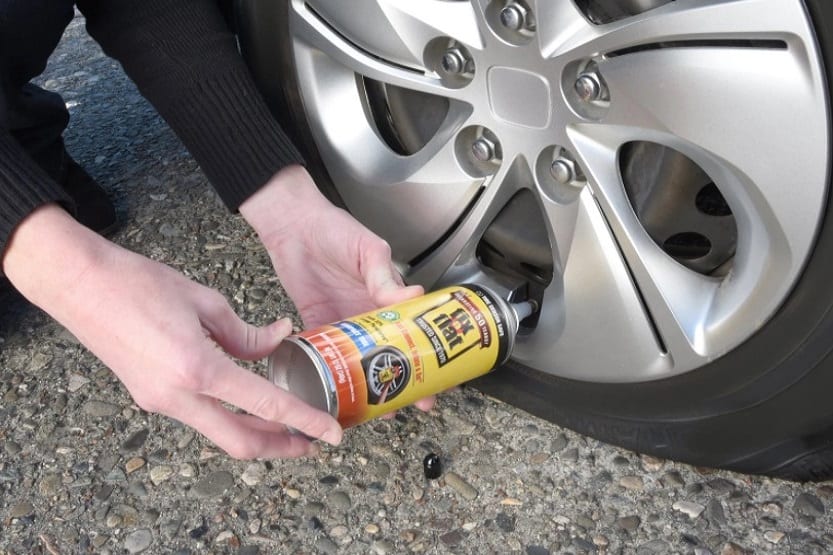
We’ve answered the question, “How long can you drive on a tire with Fix-a-Flat?” But can it be a permanent solution? Can it damage your tire?
Can Fix-a-Flat Damage Your Tire?
Using Fix-a-Flat for a leaking tire will damage it if it stays inside. Always remember that it is just a temporary solution. It is only to provide you a quick and convenient way to get out of the situation. You are still required to go to the nearest car tire service center. Pull out the tire, clean it, and have it permanently fixed.
Allowing the sealant to stay inside the tire for too long will cause it to adhere to the tire’s inside walls. It will be harder to remove from the rubber too. The tire will be knocked out of balance, so you will not be able to balance it again. The rubber will gradually break down because of the overstaying hardened sealant.
The sealant is also corrosive, so it will gradually eat at the rim of the wheel. It is unsafe to use a wheel with a defective rim. The corroded parts of the rim will be the escape route of the air inside the tire.
The lesson is that once the tire sealant has fulfilled its function, you need to remove it as soon as you can.
Practice Caution When Using Fix-a-Flat
The best way to use Fix-a-Flat is if you only intend to go to the tire shop to have the tire repaired. If you need to use it, use it cautiously and only in emergencies. The sealant contains chemicals that are not very friendly to your wheels and tires.
Below are some of the reasons why you should be careful when using this tire sealant.
1. It Can Destroy the Tire Pressure Monitoring System
Most modern cars have a TPMS or tire pressure monitoring system. This sealant can damage this system, which is very expensive to repair. Most often, it has to be replaced. So, if you can shell out extra bucks to repair your tire, do it.
The TPMS senses the pressure inside the tire through a tiny hole. When you inject the sealant into the tire, this tiny hole will be plugged – for good. If you give it to a good and industrious mechanic, he may be able to clean it out.
2. It Can Corrode Metal Parts of the Wheel
The propellant inside a can of Fix-a-Flat is R134A. This is the same substance that car air conditioners use. It is a water-based chemical substance. But when mixed with water, it becomes corrosive. This mixture is very capable of eating away rubber, aluminum, and paint.
Actually, the sealant can adhere to the tire’s rubber walls because of its slight corrosive property. But the sealant coming into contact with the rubber tends to compromise the integrity of the tire slightly.
But if you allow it to stay in contact with the rubber for too long, the tire and the rim’s integrity will be compromised. The tire will also be knocked out of balance and will vibrate if you attempt to run it fast on the road.
If you have a flat tire and have a small spare tire, use it instead of the Fix-a-Flat. The spare tire is enough to get you over to the nearest tire repair shop, even at a slow pace. It won’t compromise your safety, and you don’t have to worry about cleaning the inside of the tire afterward.

3. The Tire Wear Will Be Uneven
Fix-a-Flat cannot guarantee the even distribution of the sealant inside the tire. While it uses centrifugal force to disperse the sealant, there will still be some areas inside the tire where there will be a heavier concentration of the substance.
When the foam hardens, the weight inside the tire will be uneven. This will result in a wheel knocked out of balance, and thus, uneven tire wear. Unbalanced tires with uneven treads can’t ensure a safe drive, especially in snow or rain.
4. The Tire Rim Is at Risk
When you apply Fix-a-Flat, the can spews out liquid, which turns very shortly into a stiff and hard dry foam. The liquid also tends to get all over the rim. You need to clean it right away before it hardens. In other words, it is a very laborious process.
Some tire shops don’t even offer to clean the tire because it is such a very difficult process. If you don’t remove it, corrosion will take place. And corrosion is not good for the rim. Usually, the car owner is forced to remove the damaged tire, clean the rim, and hook up a new tire.
I am not saying that repairing a tire with Fix-a-Flat has no value. It definitely has some use, but only in emergencies. When using it, you must follow precautionary measures.
Conclusion – How Long Does Fix-a-Flat Last in a Tire?
How long can you drive on a tire with Fix-a-Flat? You can drive for 2 to 4 miles on a tire with Fix-a-Flat. You have to drive your car right after fixing it to increase the pressure inside the tire. Driving right after using Fix-a-Flat allows the sealant to be evenly distributed inside the tire wall.
Drive your car immediately to the nearest tire repair shop so they can fully fix your leaking tire. If you drive your car for longer than this, it may cause irreparable damage to your tire.
If there is any choice between a spare tire and a tire sealant, go for the spare. Then have the tire fixed permanently. But if you are in a pinch, a tire sealant works great and will get you to the tire repair shop.
Related reading:
Screw in Tire (Leak or No Leak) – What to Do?
Nail in Tire [How to Repair? What to Do?]

![Does Fix-a-Flat Work? [Is Fix-a-Flat Effective?] does fix-a-flat work](https://roadsumo.com/wp-content/uploads/2021/11/does-fix-a-flat-work-150x150.jpg)

